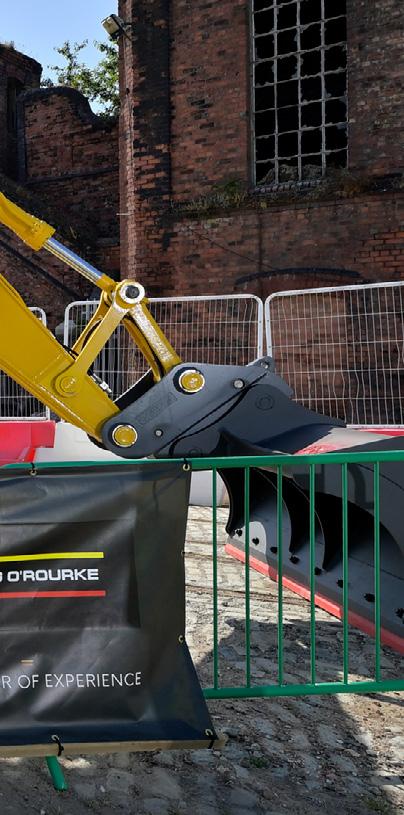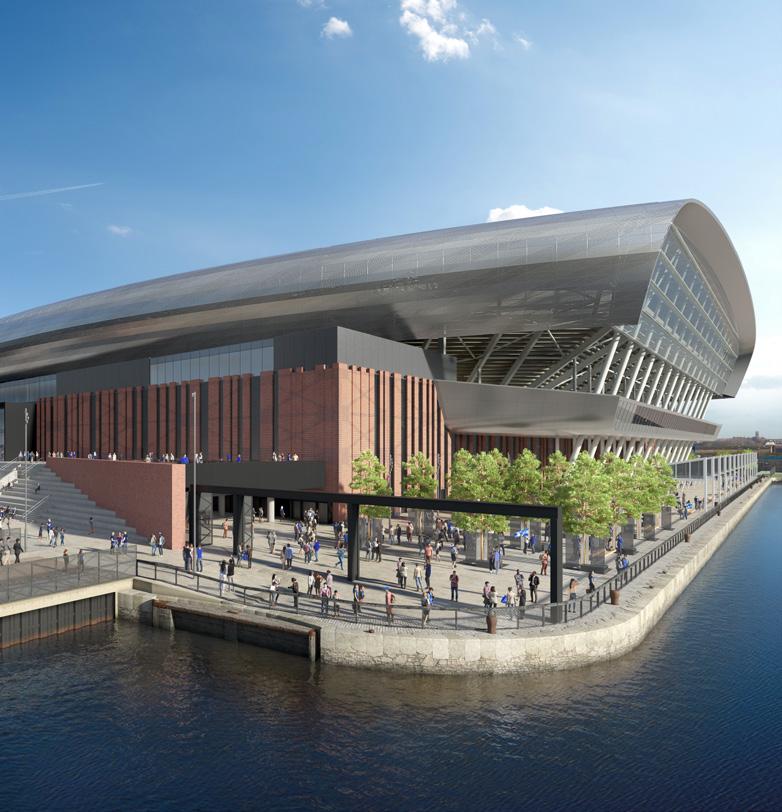
16 minute read
LESSONS FROM SOHO SIMON DANCZUK
WORDS BY SIMON DANCZUK
CHAIRMAN, DOWNTOWN LONDON IN BUSINESS
Advertisement
In 1978 John James, an economic migrant from Whitehaven in Cumbria, lands in London and manages to secure a job running the Embassy Club in Bond Street.
An offshoot of the famous New York nightclub, Studio 54, it attracts the same celebrity clientele. James recalls “I remember David Bowie; he would just walk through the door and a frisson went around the room. I’d never felt anything like that... There were loads of famous people at that time, at its height.”
It’s James’s introduction to the hospitality industry and he eventually moves to running clubs for Paul Raymond, the ‘King of Soho.’ This job morphs into running the strip-club owner and publisher’s property empire and marrying his daughter, Debbie.
Fast forward decades and the wife he divorced and ex-father-in-law have died. His daughters, Fawn and India Rose James inherit what is now Soho Estates and John James is the Managing Director. This is a major property portfolio valued well over £1 billion. It’s prime real estate, as he points out: “Soho represents the centre of the West End, and the West End represents the centre of London as a city. It brings in the most revenue, the most people, the most vitality and is one of the most prosperous areas.”
And what he and his team have been doing in recent years is: “a process of renew, redevelop, repair and replace. Since Paul’s death, making the buildings fit for a modern purpose.” The achievement can’t be underestimated. They invested in Soho House, now a major international chain, helped renovate that property and Kettner’s Hotel next door. They are just developing the former Foyles bookshop site, own property in Leicester Square, and have numerous other buildings that have, or are to be, renovated.
He rebuts any suggestion of gentrification: “Soho was a slum… you could call ‘gentrification’ giving a place a toilet, or hot and cold running water. I would say it’s become more usable by modern people and modern families and we, as a company, Paul Raymond was always in favour of the small owner/occupier business.” This philosophy has stuck with James. Speaking to others in the commercial property industry, not known for its compassion, they describe him as: “benevolent,” and “altruistic.” This shines through not least because we are speaking during a pandemic, the economic impact of which is truly shattering.
James describes the situation: “46% of the businesses on our roster are in hospitality that’s the centre of hospitality in London.” Normally: “52 million people walk from Piccadilly to the Hippodrome [in Leicester Square] per year. That tourism industry isn’t coming back quickly.”
He describes part of Soho Estates solution: “I’ll talk to my tenants about rent after a month of trading, about how to pay the rent, to defer the rent, forgive the rent.”
But he goes on to explain the other bit of his solution, the Soho Summer Street Festival campaign. We now know it’s been a success. He persuaded Westminster Council to temporarily pedestrianise many of the streets in Soho, allowing hospitality venues to spill onto the road. You can tell he understands the sector. “We need to get people trading again so we can start to recover.”
Credit to the local authority for listening, and for all those who backed his campaign, from Bill Nighy to Damien Hirst, through to Amanda Holden, and thousands more besides.
John James is one of those people you can’t help liking. He has a warm humour, has seen so much of the world and whilst has a duty to the family business, you know he also carries an exceptionally strong responsibility for part of the Capital in which he has spent most his life.
In many ways, John James arrival in London mirrored the lyrics of a Bowie song: “Bright lights, Soho, Wardour Street. You hope you make friends with the guys that you meet.” But over 40 years on James is no longer that outsider, he is now framed by the title of the song itself, he is one of ‘The London Boys.’



EVERTON BREAKS GROUND ON NEW STADIUM PROJECT
Everton Football Club has held a project commencement ceremony at Bramley-Moore Dock to mark the breaking of ground in the construction of a new £500m stadium.
The momentous occasion was attended by Everton Chairman Bill Kenwright, Chief Executive Denise Barrett-Baxendale and Players’ Life President Graeme Sharp alongside some of the project’s key planning, construction and engineering partners.



Everton Football Club has held a project commencement ceremony at Bramley-Moore Dock to mark the breaking of ground in the construction of a new £500m stadium. The momentous occasion was attended by Everton Chairman Bill Kenwright, Chief Executive Denise BarrettBaxendale and Players’ Life President Graeme Sharp alongside some of the project’s key planning, construction and engineering partners.
History was made as an Everton branded excavator made the first incision into the eastern quayside at BramleyMoore Dock as work to develop the Club’s new 52,888 capacity waterfront home begins to gather pace.
The Club took possession of the site, which forms part of Peel L&P’s £5bn Liverpool Waters scheme in the city’s Northern Docks, on Monday 26 July with construction partners Laing O’Rourke immediately working on putting in place welfare facilities for the near 12,000 construction staff that will be required during the estimated three-year build.
Everton Chairman Bill Kenwright said: “This is a momentous day. One that we have all been waiting for. To know that Evertonians and the people of this great city are together with us on this journey is a special feeling. Now that the work has commenced we can all watch our magnificent home as it comes to life. I am stating the obvious, but must reiterate that this day could not have happened without Farhad’s continued support on every level and the drive and determination of our CEO Denise, and her team.
“In a few years’ time we will, of course, be bidding the fondest farewell imaginable to our cherished home at Goodison Park. That sad day will be made easier because we know we are going to an astonishing new stadium that will bring our fans and their children - and their children’s children - the kind of joy throughout the next century that we have all shared in Liverpool 4.”
A ceremony to mark the first breaking of ground is traditional in development and forms part of the required enabling works to the eastern quayside, which will eventually become home to the Fan Plaza – an area that could welcome more than 9,000 fans on matchdays. Work is currently continuing to repair and preserve the Grade II listed dock wall, to stabilise the listed hydraulic tower, the raking of the dock floor and preparation for the demolition of existing non-listed structures. Pipework is also being


laid ahead of the infilling of the dock in the autumn. Everton Chief Executive Denise Barrett-Baxendale added: “Breaking ground is a significant milestone for this project, for our football club and our city region. It is a tangible symbol of Everton’s future and a clear signal of our Club’s ambitions.
“Today’s ceremony represents the culmination of an extensive and robust planning process. It delivers an exciting new future for our football club, invests in our local and national economy and supports our community as our region builds back better following the impacts of the global pandemic, while also ensuring the city’s oldest professional football club remains in our spiritual home of North Liverpool.
“I’m delighted we have been able to share today with the internal and external team of planning, construction and engineering partners who have worked tirelessly to make this project happen. I know for them it signifies a real starting point in the development phase of this transformational scheme.”
Everton’s new stadium project is recognised as the largest single-site private sector development in the country contributing an estimated £1.3bn to the UK economy, creating more than 15,000 jobs and attracting 1.4m visitors to the city of Liverpool. Once complete, the scheme will have acted as a catalyst for more than £650m worth of accelerated regeneration directly benefiting Peel L&P’s Liverpool Waters and the nearby Ten Streets development.
To bring fans closer to the stadium development as construction gets underway the Club will be launching a new website in the coming weeks. The site will offer news and information about progress on the Bramley-Moore Dock site as well as give supporters and stakeholders the chance to view activity on-site through a web-cam.
IT’S NOT ROCKET SCIENCE: HOW THE PROPERTY SECTOR CAN USE THE POWER OF SATELLITES
WORDS BY ALAN CROSS
AMBASSADOR NETWORK, REGIONAL AMBASSADOR - NORTH WEST ENGLAND & NORTH WALES, ESA BUSINESS APPLICATIONS UK
From the moment we wake up, to the moment we arrive at our place of work, we interact with around 25 individual satellites in Space.
Of course, as well as enabling the outside broadcasts we watch on the news over breakfast, satellites also underpin the routing and traffic avoidance apps that, in an ideal world, de-stress our commute, and provide unprecedented foresight into weather and climate conditions. Even with this in mind, it’s all too easy to think that ‘Space’ is something that only the richest governments can be involved in, but of the UKs £16.4bn space economy, more than two thirds comes from the innovative commercial use of data generated or relayed by satellites in orbit, and a further £360bn of GDP is directly supported by these services.
Consider the property sector; SME ‘Orbital Witness’ employ satellite imagery to enable regular updates on construction sites anywhere on Earth, automatically red flagging issues such as boundary violations, accelerating due diligence enquiries, and enhancing and hastening insurance queries at reduced costs. Airbus provides a Geospatial Financial Hub that delivers flood and subsidence data at address level, as well as providing a peril assessment of a customer’s portfolio with geographic concentrations of existing risk exposure. They also use space based synthetic aperture radar (SAR) to monitor the ever changing height and shape of buildings under construction so that property insurers, lenders, and investors can keep an eye on developments of interest.
Essentially, satellites can be divided into three categories: Global Navigation Satellite Systems (GNSS) such as GPS; Satellite Communications (SatCom); and Earth Observation (EO). We’re all familiar with GNSS, it guides us on road trips

and allows us to track our takeaway deliveries, but these systems have also been used to provide live data concerning wind shear on tall structures, to provide clear, accurate routing for complex supply chains and logistics, and to ensure unparalleled security for high value assets and equipment, and in the coming years we will see accuracy for GNSS improve from metres, to centimetres. Satellite communication (SatCom) is currently undergoing a revolution, with cost effective high bandwidth, low latency capabilities now available that cover almost every inch of the planet. These new services employ a ‘plug-and-play’ approach, meaning that one only need point the hub-cap sized array at the sky (rather than employ a small army of technicians) and broadband speeds become available without the need for underground cables. There also exist dedicated Internet of Things (IoT) SatCom solutions, offering match box sized robust transmitters whose battery life is measured in years – ideal for getting small amounts of data in and out of remote, mobile, or otherwise inaccessible assets that might not always be able to rely on terrestrial mobile phone networks. Finally, as the cost of manufacturing sensors, and launching them into orbit, continues to plummet, hundreds of Earth Observation (EO) satellites as small as shoe-boxes are now operated by an array of commercial entities, offering high resolution (30cm) data in the form of optical video, infrared, ultraviolet, and radar, which can revisit targets as frequently as every 24 hours. That means that changes in height, shape, boundaries, subsidence, temperature, moisture, even fallen trees or invasive structures or vehicles can be automatically detected to allow accelerated and informed decision making and actions.
It’s a lot to take in, and there are far more use-cases out there than can be highlighted here. Fortunately, both the UK and European space agency’s work together to support the development and uptake of satellite enabled services across all non-space sectors, and networks of experts are on hand to help you to understand the power of satellites, to sign post you to existing services and, should the opportunity arise, to support you in developing innovative new commercial applications for your sector.
The space above our heads bristles with thousands of beacons, sensors, and transceivers, representing a treasure-trove of data and, in the right

hands, competitive insights. In the coming decade or so, this number will grow to tens of thousands of satellites. Meanwhile, the UK is committed to doubling its space economy to 10% of the international market which, in the same time frame, could surpass a trillion USD. Whilst some of this growth will come from the sovereign development and launch of British built spacecraft and launch vehicles, more than two thirds will come from businesses like yours utilising and developing insightful products; combining your unique sector knowledge with the ever growing, ever present power of satellites.
The property business is booming… and space means business. “THE SPACE ABOVE OUR HEADS BRISTLES WITH THOUSANDS OF BEACONS, SENSORS, AND TRANSCEIVERS, REPRESENTING A TREASURE-TROVE OF DATA AND, IN THE RIGHT HANDS, COMPETITIVE INSIGHTS.”

DON’T LET THE PERFECT STORM SINK YOUR DEVELOPMENT PROJECT - ENGAGE EARLY WITH THE EXPERTS
WORDS BY BARRY ROBERTS
MANAGING DIRECTOR NORTH WEST, MORGAN SINDALL CONSTRUCTION

The construction industry is chomping at the bit to realise the Government's 'build, build, build' vision, but ongoing materials and skills shortage represent challenges.
Development projects of all sizes and types are experiencing a squeeze on supplies and talent right now. In many instances this is causing significant delays and inflated costs and is even throwing some projects off track completely.
The issue is being caused by a perfect storm of adverse market conditions. Covid-19 and the impact of Brexit have combined to result in transport and manufacturing delays. This has coincided with a worldwide increase in demand, not only for vital building materials, such as timber, steel and glass but for builders and expert tradespeople too.
With industry experts now predicting that the shortages could remain a challenge for another six months, mitigating any potential risk to project delivery must come to the fore. It's here that the early engagement of contractors can make a big difference.
This was recently identified as key principle of the Government’s recently published Construction Play-book and regardless of prevailing conditions, early engagement offers a multitude of added value benefits and should be the norm for any property team seeking to achieve the most efficient results.
EARLY ENGAGEMENT EQUALS EFFICIENT ENGAGEMENT
In recent years, the development market has seen increasing use of single-stage procurement on construction contracts, where the client appoints design consultants to map out detailed plans of the project first, before then going on to separately appoint a contractor to deliver the works.
By separating design and construction, this process can produce knowledge gaps and an illusory promise of competitive pricing and cost certainty. It often results in project budgets being exceeded and does not allow contractors the opportunity to add value for the client by collaborating with designers. Unsurprisingly, it can also cause detrimental friction between the various parties delivering the project.
The alternative is to involve contractors at the earliest stage possible, an approach described by the Institution of Civil Engineers (ICE) as 'a non-traditional procurement route, where a contractor’s skills are introduced early into a project to bring design ‘buildability’ and cost efficiencies to the pre-construction phase’.
This collaborative route, if managed effectively, ensures that insight from supply chains can be provided early, and designs can be tailored more appropriately to budget. In turn, this can mean fewer snags and projects getting to site more quickly. By working more closely with clients from the outset, contractors can anticipate and address any potential issues relating to materials and skills. The sooner they are brought on, the sooner they can liaise with their supply chain partners to source materials – providing the longer lead time needed where materials are scarce or subject to delivery delay.
An excellent illustration of early engagement in action is our work with Liverpool City Council (LCC) on the Paddington Village Central site within the city’s Knowledge Quarter. Over recent years we’ve worked on numerous projects within the site including The Spine, which was handed over earlier this summer and will be the new northern home for the Royal College of Physicians.
Here, our role goes far beyond that of traditional main contractors – our remit includes full project management, including commercial and cost planning, design procurement, programming, technical and legal.
The development of a master-plan necessitated a highly strategic partnering approach. Early engagement and full integration of Morgan Sindall Construction as contractor partner meant there was no requirement for LCC to use a separate developer to oversee the scheme, creating both efficiencies and cost savings. All projects are being designed to cost from first principles, ensuring high quality and functionality is achieved within budget.
Now, more than ever, early contractor engagement is key – a vital form of risk management in challenging times. But its value extends far beyond this. Whether your goal is maximising what you can deliver for a fixed sum, or simply lowering costs while maintaining the very highest aspirations, early contractor engagement is the answer. Through close collaboration at every stage of project delivery – including the design phase - we can create efficiencies, mitigate risk and drive greater certainty of outcome across time, cost and quality.






